GC-MS: JMS-Q1500GC Master-Quad GC/MS
DISCONTINUED
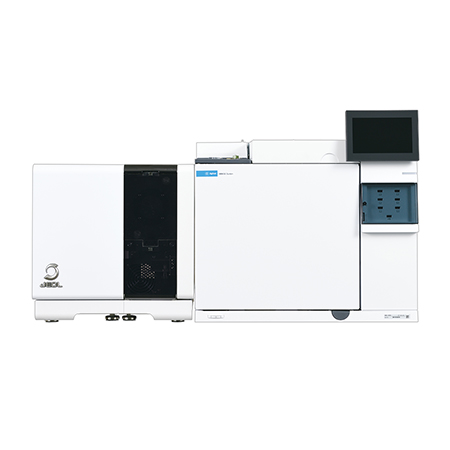
This new generation GC/MS system has excellent performance characteristics that represent a further advancement of our quadrupole MS technology. The JMS-Q1500GC can be used for a wide range of applications such as environmental analysis for agrichemicals and mold odor, material analysis, and aroma analysis.
Features
Higher Sensitivity for Scan and SIM Modes
By further improving JEOL’s Draw-in lens, the scan mode sensitivity for 1pg of OFN is improved to a S/N=>1000 which is the highest for QMS.
In SIM mode, 10 fg or lower of OFN has been achieved for the instrument detection limit (IDL).

| Injection# | RT.(min) | Area | CV% | IDL |
|---|---|---|---|---|
| 1 | 5.57 | 3065 | ||
| 2 | 5.57 | 2902 | ||
| 3 | 5.57 | 2981 | ||
| 4 | 5.57 | 2955 | ||
| 5 | 5.57 | 3028 | ||
| 6 | 5.57 | 3024 | ||
| 7 | 5.57 | 2987 | ||
| 8 | 5.57 | 3053 | 1.8% | 6.3fg |
EIC(m/z 272) from 8 times sequential measurement of 100fg OFN by SIM
New Function "PEAK DEPENDENT SIM"
This new feature simplifies the SIM grouping process. The new ”Peak Dependent SIM” function automatically sets the optimal groupings. Therefore, anyone can easily execute measurements using the optimal SIM conditions.
The maximum channel number for SIM measurements per 1 group is 100 channels, and the maximum group number is 300 groups.
In addition, the acquisition time per 1 channel can be set as desired for 0.1msec or more*.
Depends on the selected SIM setting mode
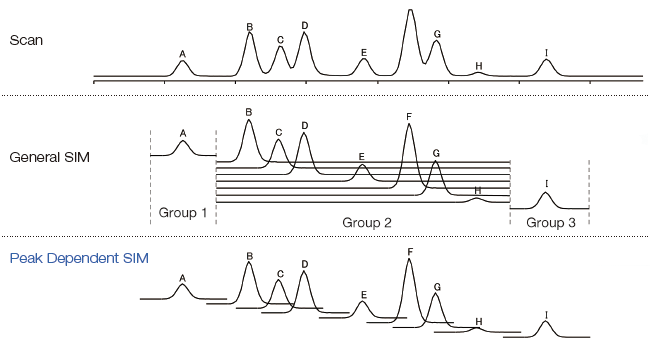
Sensitivity Comparison between Peak Dependent SIM Condition and General SIM Condition
Use of Peak Dependent SIM function improves the sensitivity by 2.4 to 5.5 times compared with the results measured by using the general SIM conditions (Comparison among 3 agrichemicals).

Simple Maintenance with Reduced Cost
Simple Maintenance with Reduced Cost
The JMS-Q1500GC utilizes a larger ion source window to simplify the ion source maintenance. No tools are required to remove or insert the ion source chamber.
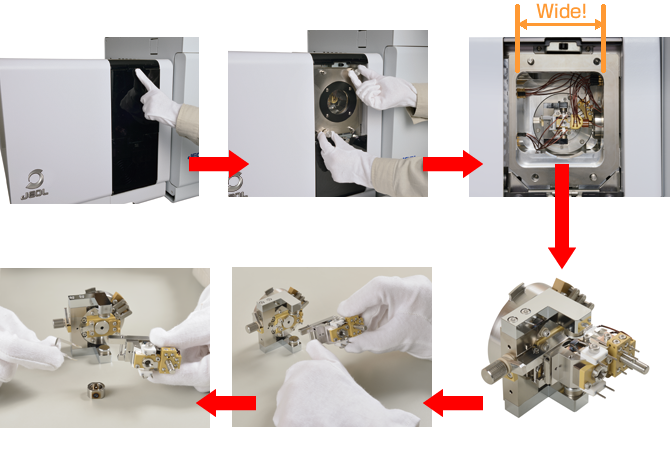
GC/MS Comprehensive Analysis Software “Escrime”
Our Escrime software is a comprehensive analysis software that provides easier and more efficient data analysis of GC/MS data. This software also offers an updated user environment. The qualitative analysis portion of the software has been updated to consolidate all of the necessary qualitative information into one window. All peak information is controlled by the peak list, which enables an efficient spectrum analysis, library search, chromatogram creation, etc.
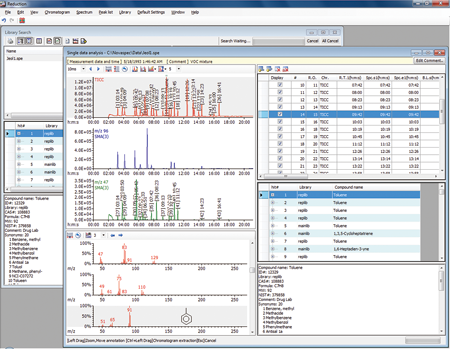
The Escrime and MSPRIMO™ software packages are directly linked so that the qualitative and quantitative conditions are easily adjusted, thus improving the overall ease of operation relative to previous versions of the system. The quantitative analysis of multiple samples with multiple component is much easier to handle within Escrime. Additionally, the quantitative analysis report format can be customized according to the needs of the researcher.

Options
Head Space Auto Sampler(HS) GC/MS System
A Head Space Sampler is a pre-treatment device used for the analysis of volatile organic compounds (VOC) generated from solids and liquids.
The Head Space Auto Sampler developed at JEOL is a unique HS system that comes standard with two modes of operation: loop mode and trap mode.
Mold odors in water were detected down to 1ppt, which is difficult to accomplish using the conventional loop mode.
Moreover, it can be applied to volatile component such as food, material, etc.
The photo shows the JMS-Q1500GC GC/MS combined with JEOL’s Head Space Auto Sampler.

Pyrolysis GC/MS System
Pyrolysis GC/MS is an analytical technique that combines a pyrolyser with a GC/MS. This technique is very useful for the analysis of organic compounds generated from samples that are subjected to pyrolysis conditions. It can be used for the analysis of polymer materials such as synthetic polymers, rubbers, etc.

Direct Insertion Probe
DIP/DEP
The JMS-Q1500GC also has two types of optionally available sample inlet probes. Each probe is ideal for different types of samples in different physical states.

Direct Insertion Probe/C
(Direct Insertion Probe:DIP)
Solid or solution sample are put in a narrow glass tube and then heated by the probe heater.
The components generated by heating are then ionized within the ion source.

Direct Insertion Probe/F
(Direct Exposure Probe:DEP)
Samples dissolved in solution are applied to a Pt filament. Afterwards, an electric current is applied to the filament to rapidly heat the sample.
The desorbed components are then ionized within the ion source.
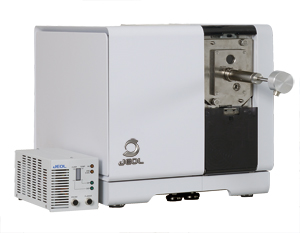
JMS-Q1500GC with the direct insertion probe
Reduced Running Costs
The eco-friendly design reduces the consumption of electricity from the existing model by 10%.

Application
Application JMS-Q1500GC
Ionization Methods for JEOL Mass Spectrometers -A Guidebook-
Related Products
Related Products

msFineAnalysis series GC-MS integrated qualitative analysis software
You no longer have to only rely on library DB searches for qualitative analysis!
msFineAnalysis series
The msFineAnalysis series is an automatic qualitative analysis software that enables "integrated analysis" by combining the library database (DB) search using EI data and molecular weight confirmation using soft ionization data.
"  msFineAnalysis iQ" is designed for low resolution integer mass data analysis, and"
msFineAnalysis iQ" is designed for low resolution integer mass data analysis, and"  msFineAnalysis" is designed for high resolution exact mass data analysis. Each package improves analysis accuracy, shortens work hours, and improves work efficiency.
msFineAnalysis" is designed for high resolution exact mass data analysis. Each package improves analysis accuracy, shortens work hours, and improves work efficiency.
More Info
Are you a medical professional or personnel engaged in medical care?
No
Please be reminded that these pages are not intended to provide the general public with information about the products.
